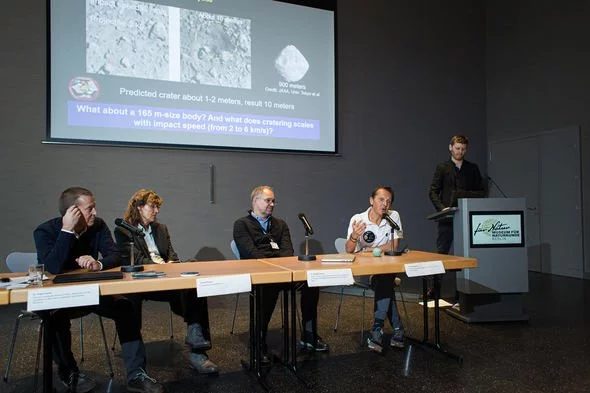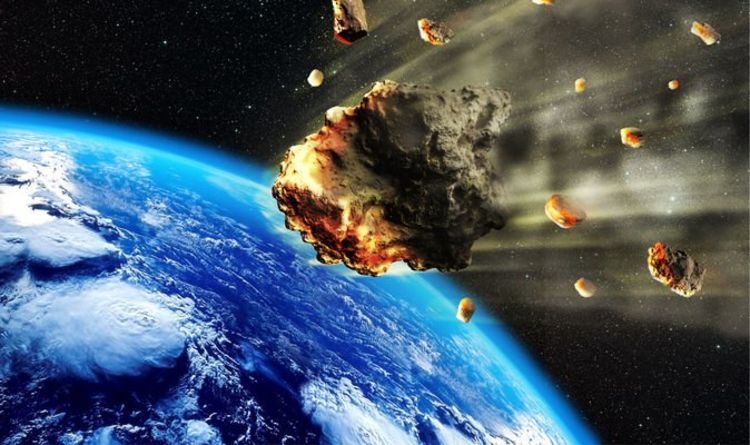The campaign dubbed Support Hera and initiated by the co-founders of Asteroid Day hopes to influence more research into safeguarding Earth from future impacts.
Hera is the European Space Agency's (ESA's) planetary defence and asteroid deflection mission ran in partnership with the US space agency NASA.

Support Hera was launched with support from the Max Planck Institute for Solar System Research and the Observatoire de la Côte D'Azur in France.
Asteroid Day co-founder Grig Richters said: "More than 1200 prominent scientists and citizens from around the world have signed a letter in support of Hera because studying NEOs cannot be under-appreciated and the Hera mission is core to gaining the knowledge we need to detect and ultimately deflect dangerous asteroids headed towards Earth."
During a press conference in Berlin, the campaign's organisers unveiled a letter to European minsters signed by more than 1,200 concerned individuals.
The letter reads: "Unlike other natural disasters, an asteroid impact with Earth is not only one we know how to predict but one we can prevent, by means that just need to be tested.
Comment: This statement is perhaps a little too confident. Recently there have been a number of asteroids that were only detected as they were whizzing past Earth; added to that there's 2 newly discovered interstellar objects. And so it would appear we're woefully unaware and unprepared for the the potential threats to our planet. NASA astronomer Amy Mainzer gives an overview of the numbers:
[...] scientists have identified more than 90 percent of the objects large enough to cause a global-scale disaster.
But moving down the size scale, the census is far spottier. Only about 30 percent of medium-size objects - 140 meters (460 feet) in diameter or larger - have been spotted. And she said only about 1 percent of objects have been found that are the size of the Tunguska impactor, which was about 40 meters (130 feet) in diameter. She said she welcomed the idea of a special effort to look for objects during the Taurid swarm in June.
"Today, we are the first generation of humans who have the necessary technology to try to change the trajectory of an asteroid."
According to the letter, asteroids upwards off 328ft (100m) across are large enough to cause "severe damage" over many thousands of square miles.
But scientists have only uncovered less than 20 percent of these bodies in the solar system.
Knowledge we need to detect and ultimately deflect dangerous asteroids headed towards Earth
Even an asteroid as small as 32ft (10m) across can pack the punch of an atomic bomb if it strikes the planet.
When an undetected 65.6ft-wide (20m) rock exploded in the skies over Russia's Chelyabinsk Oblast in 2013, it injured more than 1,000 people with shards of broken window glass.
Missions like HERA and NASA's Double Asteroid Redirection Test or DART will test our ability to push these rocky bodies away from Earth before they hit.
The joint mission will target a 2,560ft (780m) asteroid and its smaller 524ft (160m) companion.
You can read more about NASA's daring asteroid defence plan here.
Hera Principal Investigator Dr Patrick Michel said: "New NEOs are now being discovered at the rate of some four per day.
"We need a coordinated international strategy for near-Earth object impact mitigation."
He added: "The Hera and DART missions, under the coordinated AIDA collaboration of scientists, will give us the unique possibility to test our capabilities to deflect an asteroid, combined with fascinating science."
Dr Holger Sierks from the Max Planck Institute said: "It is now that we have the knowledge about the surface of comets and asteroids from space missions as Rosetta and Dawn - and based on this experience we are best prepared for a mission on asteroid deflection."
According to NASA, the currently known asteroid count stands at 840,170.
Most of these rocky objects are found in the Asteroid Belt between Mars and Jupiter.
Geologist Gisela Pösges said: "For me who lives in an Impact crater, the Ries Crater, the danger from space is very obvious.
"The Ries Event destroyed an area from more than 4,500 cubic kilometres.
"That means if such an Impact Event would take place today at the same place the area which is located in a triangle made by the three big City in Southern Germany Nuremberg in a northeast direction, Stuttgart in western direction and Munich in a southeast direction - all three cities are 100 km away from the point of impact - would be wiped out."





Targeted emotional reaction triggers willing sacrifice - or redirection of energy. funds and lives.
Protection rackets tax by stealth for loveless of hidden agenda.
Is this about possession and control of orbital or near 'space'?
As part of possession and control of you/us.
Technologists want money to make new toys.
Govs 'compete' for weapon and shield advantage
The Corp owns the Govs and hires the Techs.
To max the profiting and security of the revenue stream against fear of loss of
a proprietary possession and control.
Saving Life on Earth
for slavery unimagined.
Satellites of love?
Any State that seeks to possess and control makes its citizens its food-source and their awakening to their complicity, the enemy. And so any and every diversion and displacement to induce a sympathy for love set against fear to sacrifice love to an ongoing permanent overriding need, state of emergency, martial law, Security override or perpetual war normalised as all that remains of 'the peace'.
Fearful imagination can create a full emotional reaction as if the event is imminent, inevitable or already happening. Just look at the so called Green mind-capture!
I understand that those in 'power' are desperate for the sustainability of their own worldview, but piling ever more lies and layers of defence is only delaying the inevitable reckoning - which I understand might seem like a divine vengeance - but is simply the broad spectrum breakdown of the capacity to be-live the lie of a life to the revealing of a truth discarded and forgotten under symbolic substitution - as if the answer - or the problem - is Out There! The use of the past to imprint upon the present as a way to persist the past into the future is the control of the present. Orwell described this in his 1984 picture of a world of slavery but offered no way out. Control of the present is a choice to NOT yield to the presence - indeed a 'planetary defence' set against the awakening presence. It is a losing battle because such a 'self' has to battle itself to generate a shield of diversion and limitation over the heart's recognition - as if to protect what remains of love from a convicted guilt and penalty so as to limit total loss.
An 'extinction rebellion', brings it on.
Aligning in the presence of the heart has to put fear in its place - and not in charge of the darkness brigade.
Human self hating CALLS destruction by definition and having ALREADY usurped our right Mind - will take on such in advance of the 'retribution' as its self-vindicating validation. Love has no say - because the science is set and there is no debate. The treachery and deceit of the idea of a love that embraces and shares life on Earth is a virus to be eradicated by systemic controls set out of reach of any possibility of interference.
Technology cannot answer our problems unless used to empower answer we have already accepted in our heart.
We are cocreating a world in which